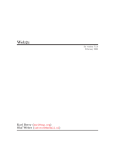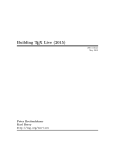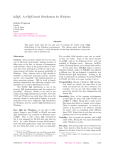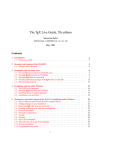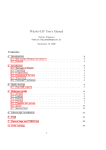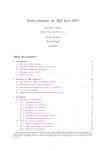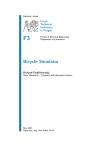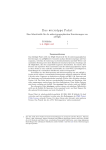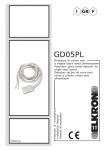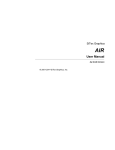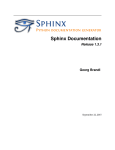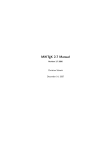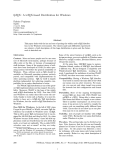Download The teTeX Manual
Transcript
teTEX Manual
Thomas Esser
January 2005
Abstract
teTEX is a distribution of TEX and related programs: pdfTEX, e-TEX, Omega,
Aleph, LATEX, ConTEXt, METAFONT, METAPOST, dvips, xdvi, dvipdfm, dvipng,
BIBTEX, makeindex etc.
teTEX aims to make using and maintaining a TEX system as easy as possible. The
programs are built around the Web2c distribution by Karl Berry and Olaf Weber.
A common part of many programs is kpathsea, a library that provides efficient
access by name to files stored hierarchically.
This document describes how to use and set up the teTEX system. It does not
attempt to be a comprehensive guide, instead it tries to give an overview about
what software and documentation is contained in the distribution.
1
Contents
1
2
The Components of teTEX
1.1 Web2c . . . . . . . . . . . . . . . . . . . . . . . . . . . .
1.2 TEX extensions: pdfTEX, e-TEX, Omega, Aleph, encTEX
1.3 DVI drivers: dvips, dvilj, xdvi, dvipdfm, dvipng . . .
1.4 Makeindex . . . . . . . . . . . . . . . . . . . . . . . . .
1.5 Texinfo . . . . . . . . . . . . . . . . . . . . . . . . . . .
1.6 UNIX Scripts / Tools . . . . . . . . . . . . . . . . . . .
.
.
.
.
.
.
.
.
.
.
.
.
.
.
.
.
.
.
.
.
.
.
.
.
.
.
.
.
.
.
.
.
.
.
.
.
.
.
.
.
.
.
.
.
.
.
.
.
.
.
.
.
.
.
.
.
.
.
.
.
.
.
.
.
.
.
3
3
3
4
5
5
5
Concepts and configuration
2.1 The TEX Directory Structure (TDS) . . . . .
2.2 Overview of the predefined texmf trees . .
2.3 The file name database (ls-R) . . . . . . . .
2.4 Runtime configuration (texmf.cnf file) . . .
2.5 Using Postscript type 1 fonts . . . . . . . . .
2.6 Configuration files maintained by texconfig
2.7 Automatic font generation . . . . . . . . . .
2.8 TCX files . . . . . . . . . . . . . . . . . . . .
2.9 Creating PDF files . . . . . . . . . . . . . . .
.
.
.
.
.
.
.
.
.
.
.
.
.
.
.
.
.
.
.
.
.
.
.
.
.
.
.
.
.
.
.
.
.
.
.
.
.
.
.
.
.
.
.
.
.
.
.
.
.
.
.
.
.
.
.
.
.
.
.
.
.
.
.
.
.
.
.
.
.
.
.
.
.
.
.
.
.
.
.
.
.
.
.
.
.
.
.
.
.
.
.
.
.
.
.
.
.
.
.
7
7
8
9
9
9
10
12
12
13
.
.
.
.
.
.
.
.
.
.
.
.
.
.
.
.
.
.
.
.
.
.
.
.
.
.
.
.
.
.
.
.
.
.
.
.
.
.
.
.
.
.
.
.
.
.
.
.
.
.
.
.
.
.
3
Release notes for teTEX 2.0
4
Release notes for teTEX 3.0
4.1 New programs / font support / macro packages . . . . . .
4.2 Changes to web2c . . . . . . . . . . . . . . . . . . . . . . . .
4.3 Modifications to the directory structure and file searching .
4.4 Changes to texconfig / updmap / fmtutil . . . . . . . . . .
4.5 Changes to pdfTEX . . . . . . . . . . . . . . . . . . . . . . .
4.6 pdfetex: the new default TEX engine . . . . . . . . . . . . .
4.7 Changes to xdvik . . . . . . . . . . . . . . . . . . . . . . . .
4.8 Changes to dvipsk . . . . . . . . . . . . . . . . . . . . . . .
4.9 Improved documentation . . . . . . . . . . . . . . . . . . .
5
14
Resources
5.1 Helpindex file for the documentation tree . . .
5.2 Internet Newsgroups . . . . . . . . . . . . . . .
5.3 TEX User Groups . . . . . . . . . . . . . . . . .
5.4 Mailing Lists . . . . . . . . . . . . . . . . . . . .
5.5 Comprehensive TeX Archive Network (CTAN)
5.6 The TEX Catalogue . . . . . . . . . . . . . . . .
5.7 Frequently Asked Questions (FAQs) . . . . . .
2
.
.
.
.
.
.
.
.
.
.
.
.
.
.
.
.
.
.
.
.
.
.
.
.
.
.
.
.
.
.
.
.
.
.
.
.
.
.
.
.
.
.
.
.
.
.
.
.
.
.
.
.
.
.
.
.
.
.
.
.
.
.
.
.
.
.
.
.
.
.
.
.
.
.
.
.
.
.
.
.
.
.
.
.
.
.
.
.
.
.
.
.
.
.
.
.
.
.
.
.
.
.
.
.
.
.
.
.
.
.
.
.
.
.
.
.
.
.
.
.
.
.
.
.
.
.
.
.
.
.
.
.
.
.
.
.
.
.
.
.
.
.
.
.
.
.
.
.
.
.
.
.
.
.
.
.
.
.
.
.
.
.
.
.
.
.
.
.
.
.
14
14
14
15
16
17
17
17
18
18
.
.
.
.
.
.
.
18
19
19
19
19
20
20
20
1
The Components of teTEX
This document cannot describe all the programs which are part of teTEX in detail, but it
tries to give you an overview. This section describes the packages which form the main
components of teTEX.
1.1
Web2c
Web2c is a TEX implementation, originally for Unix, but also running under Windows,
Macintosh, DOS, Amiga, and other operating systems. It includes TEX itself and the
following programs:
• METAFONT: a font compiler intended to produce typefaces of high quality [1].
• METAPOST: a program similar to METAFONT, modified to output Postscript code
instead of bitmaps. Documentation for METAPOST is available via the command:
texdoc mpman.
• BIBTEX: a preprocessor to make bibliographies for LATEX. For documentation, see
texdoc btxdoc and Appendix B of [2].
• utilities for converting between different font metric and bitmap formats: gftopk,
gftodvi, gftype, pktogf, pktype, pltotf, tftopl, vftovp, vptovf.
• DVI utilities: dvicopy, dvitomp, dvitype.
• other tools: patgen, pooltype, tangle, weave, ctangle, cweave.
The main documentation for Web2c is the “Web2c manual” and the “kpathsea manual”. These can be accessed via texdoc web2c and texdoc kpathsea respectively.
1.2
TEX extensions: pdfTEX, e-TEX, Omega, Aleph, encTEX
Besides the standard TEX program, the following extensions to TEX are included in
teTEX:
pdfTEX This can optionally write Acrobat PDF format instead of DVI. The user manual
can be accessed by the command texdoc pdftex-a. The LATEX hyperref package
( texdoc manual) has an option “pdftex”, which turns on all the program features. In DVI mode, pdfTEX works like the usual TEX with the exception of the
availability of additional typographic features.
In PDF mode, pdfTEX supports graphics inclusion for the following graphic formats:
• PNG (portable network graphics)
• PDF (portable document format),
• JPG (jpeg)
3
• MPS (metapost output)
It does not support EPS (encapsulated postscript), but if you have recent versions
of ghostscript (version 5.10 or later) and perl (version 5 or later) installed, you
can use the tool epstopdf to convert EPS graphics into PDF. When including a
PDF file, pdfTEX is able to access parts of a multi-page file: a complete page or a
clipped part of a page. This feature extends pdfTEX beyond its typesetting capabilities into a versatile tool for handling arbitrary generated PDF files.
e-TEX adds a small but powerful set of new primitives, and an extension for right to
left typesetting. In default mode, e-TEX is 100 % compatible with ordinary TEX.
See texdoc etex-man for details.
Omega (Ω) Omega works internally with 16-bit Unicode characters; this allows it to
work directly with almost all the world’s scripts simultaneously. It also supports
dynamically loaded “Ω Translation Processes” (OTPs), which allow the user to
define complex transformations to be performed on arbitrary streams of input.
Documentation: texdoc doc-1.12.
Aleph is a TEX engine that combines the good features of eTEX and Omega. The LATEX
based format of Aleph is called Lamed.
1.3
DVI drivers: dvips, dvilj, xdvi, dvipdfm, dvipng
For printing and previewing DVI files, you need to use one of the DVI drivers that are
available:
dvips This driver converts DVI files into Postscript. Postscript is a page description
language that many laser printers directly support. With the help of the utility
ghostscript, it is possible to view Postscript documents on screen and to print
Postscript documents on non-Postscript printers. This version of dvips supports
hypertex and partial font downloading. In this release, the search path for config
files have been changed: the current directory is no longer searched by default.
Additionally, secure mode has been turned on by default. For details, consult the
documentation: texdoc dvips.
dvilj This is a family of drivers to support HP LaserJet (and compatible) printers:
dvilj, dvilj2p, dvilj4, dvilj4l, dvilj6. These drivers are faster than the
dvips + ghostscript alternative (which can also be used to print DVI files on
HP LaserJet printers), but they lack a few features like support for virtual fonts,
rotated or scaled graphics, etc.
xdvi This is a previewer for DVI files under the X Window System. It has support
for Postscript specials through Display Postscript, NeWS and ghostscript. Hypertex support was also added for this version of xdvi. A link can be followed
by clicking with Button-1 or Button-2 (open link in a new window) on it. With
4
the help of source specials, xdvi can interact with most editors in some way. For
details, visit the project page.
dvipdfm This program can convert dvi files into pdf format, while supporting a rich
set of features (via TeX’s \special scheme): hyperlinks, bookmarks, thumbnails,
image inclusion etc. For details consult the documentation texdoc dvipdfm and
the web page.
dvipng makes PNG and/or GIF graphics from DVI files as obtained from TeX and its
relatives. For details, consult the documentation: texdoc dvipng.
1.4
Makeindex
makeindex is a general purpose hierarchical index generator; it accepts one or more
input files (often produced by a text formatter such as TEX or troff), sorts the entries,
and produces an output file which can be formatted. The formats of the input and
output files are specified in a style file; by default, input is assumed to be an idx file, as
generated by LATEX. Documentation: texdoc makeindex
1.5
Texinfo
texinfo is a documentation system. It produces online or printed output from a single
source. It uses TEX to typeset documents for printing (texdoc texinfo).
1.6
UNIX Scripts / Tools
If you are using teTEX under UNIX, you can use the following scripts. More documentation for a specific tool can either be obtained from its UNIX manual page or by running
the program with the option –help.
texdoc allows you to easily access documentation included with teTEX. You only have
to remember the file name of the document that you want to access, without the
directory part. If you do not specify a file name extension (such as .dvi) texdoc
will try a few default extensions. After searching the file, texdoc starts an appropriate viewer. The command texdoc –help gives you a list of available command
line options. While texdoc is a fast and efficient tool if you exactly know what
you are searching for, it is of limited use if you don’t know the exact name of the
documentation file.
texdoctk This perl/tk based tool allows you to browse through the available documentation by some topics and to search for keywords. It uses a simple database
file for its configuration (named texdoctk.dat), which you can customize and
extend easily.
texconfig allows you to carry out the most common configuration tasks in teTEX. The
program can be used in command mode or in interactive mode. For the interactive mode (which is invoked by calling texconfig without arguments), a curses
5
based utility is used for user interaction (menus, check boxes, . . . ). The command
texconfig help shows you a list of available command line options (command
mode).
texconfig can be used to set up TEX format files and their hyphenation patterns,
to set up printers (for dvips) and for a few other things. It manipulates configuration files to store the configuration changes.
If the use of texconfig causes a change in some configuration file, texconfig will
try to save that file into the texmf tree that is specified by the TEXMFCONFIG variable. Variable (cached) runtime data (such as format files generated by fmtutil,
map files generated by updmap) will be stored in the texmf tree specified by the
TEXMFVAR variable.
updmap Some tools in teTEX support Postscript Type 1 fonts: dvips, pdfTEX, xdvi,
dvipdfm and gsftopk, ps2pk. The last two in this list just convert outline fonts
into a bitmap format which is helpful for applications that don’t directly support
outline fonts. In an ideal world, all of these programs would share a common
configuration file to set up their outline fonts. The reality is different, however,
and each tool needs its own configuration. The updmap utility was developed to
generate these configuration files from a central repository. Adding font definitions for all supported applications from a map file foo.map can be as easy as
updmap --enable Map foo.map. For details, please consult the manual page of
updmap.
dvired This script can be used to print documents formatted for A4 paper 2-up (i.e.
two logical pages to one physical page of paper) by scaling the pages to 70.7 %
of their original size. dvired can just be used in the same way as dvips (same
command line options).
dvi2fax This script converts DVI files into FAX G3 format. It uses ghostscript (see:
http://www.cs.wisc.edu/~ghost/) which is not part of teTEX. The DVI file is
first converted to Postscript (204 × 196 dpi or 204 × 98 dpi) and then to FAX G3
using ghostscript (faxg3 device).
allcm, allec, allneeded teTEX’s DVI drivers generate missing bitmap fonts on demand
(the first time they are needed). If you start with a fresh installation, you don’t
have any bitmap fonts and the delay caused by font generation might be too annoying for you. In that case, the three scripts allcm, allec and allneeded can
help you. allcm and allec create a few DVI files (using LATEX) which use lots
of fonts at various sizes and run these DVI files through dvips. This triggers the
generation of the most commonly used Computer Modern (allcm) and European
Computer Modern (allec) fonts respectively. You might already have DVI files
and want to generate just the bitmap fonts needed by these documents. This can
be done by the allneeded script. This script will search a given set of directories for DVI files and run them through dvips. All these scripts just trigger font
generation. LATEX and DVI files generated by allcm/allec are removed when
6
the program terminates. Postscript output that is generated by dvips is sent to
/dev/null.
These programs accept the command line option “-r” (must be the first option) to
generate files for the magnification 707/1000 which is used by dvired. allneeded
passes options which correspond to existing file or directory names to find (for
locating DVI files). All other options given to any of these three utilities are passed
to dvips. So, by passing -D NNN -mfmode some-mode or -P some-printer, you
can generate fonts for a specific resolution (NNN ) and mode (some-mode) or for a
specific printer (printer).
2
2.1
Concepts and configuration
The TEX Directory Structure (TDS)
teTEX’s support tree with fonts, macros, documentation and other files (from now on
called the “texmf tree”) follows a certain structure: the TEX Directory Structure (TDS).
This is a standard developed by a TEX Working Group of TUG. The TDS is defined in a
way so that can be used by different implementations of TEX on different platforms. Today, several TEX distributions follow this standard: teTEX, TEX Live, fpTEX and miktex,
only to mention some. You need to understand this structure if you want to build your
own texmf tree (e.g., with all your local additions) or add files into an existing texmf
tree. The list of all texmf trees (optionally using some notation called “brace expansion”
and !! modifiers; the kpathsea manual explains this in detail) can be obtained by:
kpsewhich -expand-var=’$TEXMF’
Table 1 gives a short overview of the TDS. It shows the proper location inside the
TDS tree for several kind of files. The complete documentation for TDS can be accessed
by texdoc tds. If you want to see some examples, just look at the main texmf tree of
teTEX. It has several thousand files.
TEX macros
font files
METAFONT files
documentation
sources
BIBTEX files
tex/hformati/hpackagei/
fonts/htypei/hsupplieri/htypefacei/
metafont/hpackagei/
doc/hpackagei/
source/hpackagei/
bibtex/{bst,bib}/hpackagei/
Table 1: TDS: an overview
The replaceable parts in this table mean:
hformati The name of the TEX format, e.g., latex or amstex.
hpackagei The name of the package to which the file belongs, e.g., babel or seminar.
7
htypei The name of the type of a font file, e.g., pk (packed bitmap), tfm (tex font metric),
afm (adobe font metric), vf (virtual font), or source (METAFONT source).
hsupplieri The name of the font supplier (to whom the font file belongs), e.g., adobe or
urw.
htypefacei The name of the typeface name (for this font file), e.g., times or cm (for
Computer Modern).
It is important to know that the default search paths in teTEX rely on this directory
structure. So, if you add a file to the wrong directory tree, e.g., a TeX macro somewhere
in the fonts subtree, that file will not be found correctly.
2.2
Overview of the predefined texmf trees
As described in the previous section, each texmf tree follows a well defined directory
structure. This section lists all predefined texmf trees and their intended purpose. The
command texconfig conf shows you the values of the variables below, so that you
can easily find out how they map to directory names in your installation.
TEXMFCONFIG The tree specified by this variable will be used by teTEX’s utilities
texconfig, updmap and fmtutil to store modified configuration data.
TEXMFVAR The tree specified by this variable will by used by the utilities texconfig,
updmap and fmtutil to store (cached) runtime data such as format files and generated map files.
TEXMFHOME The expansion of this variable typically depends on $HOME, so this dynamically adjusts for each user to an individual directory. The idea is to allow
users to store their own versions of macros, fonts etc. in this tree.
TEXMFSYSCONFIG The tree specified by this variable will be used by the utilities
texconfig-sys, updmap-sys and fmtutil-sys to store modified configuration
data.
TEXMSYSFVAR The tree specified by this variable will by used by texconfig-sys,
updmap-sys and fmtutil-sys to store (cached) runtime data such as format files
and generated map files.
TEXMFMAIN This variable specifies the texmf tree where some vital parts of the system are installed, such as helper scripts (e.g. web2c/mktexdir), pool files and
other support files.
TEXMFLOCAL This variable names a directory tree which should be used for systemwide installation of additional or updated macro packages, fonts etc.
TEXMFDIST This variable names the directory tree which holds the macros, fonts etc.
as originally distributed.
8
2.3
The file name database (ls-R)
texmf trees can get very large and to speed up searching in such a tree, a file name
database is used. A file name database exists in the root of each texmf tree and has the
name ls-R. It should list each file in the texmf tree. The command texhash can be used
to build an up-to-date file name database for each texmf tree. It should be used after
files have been added to a texmf tree. However, you don’t need to run texhash for files
added by the automatic font generation or the texconfig utility.
2.4
Runtime configuration (texmf.cnf file)
Search paths and other definitions (e.g., the static sizes of some arrays in TEX or other
programs) can be set up in configuration files named texmf.cnf. By changing the definitions in these configuration files (teTEX’s main texmf.cnf is web2c/texmf.cnf in the
main texmf tree), the behavior of programs can be changed without recompiling them.
Chapters 3 and 4 of the kpathsea manual ( texdoc kpathsea) describe the path searching configuration in detail. Section 2.5 of the Web2c manual ( texdoc web2c) describes
some interesting runtime parameters that you might want to change.
Some changes to the array sizes require you to rebuild the dump files that the program uses. Run the command texconfig init to rebuild all dump files after you have
changed one of the array sizes.
This implementation of TEX can read and write files (as can every implementation of
TEX) and it can also call external commands (via the \write18 stream). Some variables
in the texmf.cnf file control access to these features. The possibility to call external
commands can be turned on or off (default is off). Access to file beginning “.” is disallowed in restricted mode (default for reading files). In paranoid mode, file access is
even more restricted and you cannot access files outside the current directory tree (default for writing files). If the first line of a document starts with %&, it can be used to
pass the name of the format file and/or a TCX file. Parsing the first line, is an extension
that can be turned on or off (default is off) in the texmf.cnf file.
2.5
Using Postscript type 1 fonts
For every font you use with TEX, a TFM (TEX font metric) file is needed. Type 1 fonts
usually do not have the same encoding that is used by TEX, so additional metrics that do
some re-encoding (virtual font files) are often needed. For a lot of font families, these
font metric files and additional map files that you need (see below) can be found on
CTAN servers in the directory fonts. If support for your fonts cannot be found there,
you can use the fontinst utility (documentation: texdoc fontinst) to create these.
Postscript type 1 fonts can be used by dvips, dvipdfm, xdvi, gsftopk, ps2pk and
pdfTEX. All of these programs require that you set up map files for these fonts. To ease
the process of adding map file entries to the configuration files that are used by these
tools, you should follow the following steps:
9
• if your fonts already come with a map file, put that file into the fonts/map/dvips/
misc directory in the main texmf tree.
• otherwise, you will need to create a map file yourself, using the syntax as described in the dvips manual (texdoc dvips); make sure to set up these fonts as
“download fonts”, not as “built in” fonts.
• run the command texhash and then make the map file known to updmap by running the command updmap --enable Map file.map (where file.map denotes
the filename of your map file)
The programs gsftopk and ps2pk convert Postscript type 1 fonts into bitmap fonts
and make these fonts accessible to DVI drivers that do not directly support Postscript
type 1 fonts. This conversion is automatically invoked by the mktexpk script. That
script calls gsftopk by default. If you do not have installed the ghostscript program
(which gsftopk needs), or if you want to use ps2pk for other reasons (e.g., because it
is usually faster) you just need to define the variable ps_to_pk to ps2pk. This variable
can be set in your environment or in the mktex.cnf file (see below).
2.6
Configuration files maintained by texconfig
The texconfig utility is a user interface for changing the configuration of the teTEX
system. The configuration is stored in several individual files. This section documents
the names of these files, their location in the texmf tree and their content. This explains
how texconfig works and enables you to manually configure parameters which are
not supported by texconfig.
• dvips/config/config.ps stores configuration information for dvips. The default values are: 600 dpi resolution; ljfour METAFONT mode; A4 paper; offset for
printing: 0pt,0pt; output goes to lpr command.
• tex/generic/config/pdftexconfig.tex This file sets some defaults for pdfTEX,
e.g. the default paper size. This information is dumped into format files, so if you
modify this file directly (without using texconfig), you have to rebuild the format
files by using the command fmtutil --all.
• xdvi/XDvi This file sets some defaults (e.g. media size, metafont mode) for xdvi.
It is read via the app-default mechanism of X11. You can override these appdefaults as usual (i.e. via a file ~/.Xdefaults or with resources managed by xrdb).
• dvipdfm/config defines the defaults for dvipdfm, e.g. the default paper size, the
command to convert encapsulated postscript graphics into PDF etc.
• web2c/mktex.cnf This file sets the default metafont mode used for automatically
generated bitmap fonts, the resolution which is used in scripts (e.g. mktextfm)
and a list of “features” used for automatic font generation. The most important
“features” are described below; for a full list, see section 2.2.9.1 of the kpathsea
manual ( texdoc kpathsea).
10
appendonlydir Set the sticky bit on directories that have to be created. The sticky
bit has the effect that a file in such a directory can only be removed by the
owner of that directory or by the owner of that file.
varfonts When this option is enabled, fonts that would otherwise be written to
some texmf tree go below the VARTEXFONTS directory instead. The default
value is in /var/tmp/texfonts. The “Linux File System Standard” recommends /var/tex/fonts. The varfonts setting in MT_FEATURES is overridden
by the environment variable USE_VARTEXFONTS: if set to 1, the feature is enabled, and if set to 0, the feature is disabled.
texmfvar Force generated files that would go into a system tree (as defined by
SYSTEXMF) into TEXMFVAR. The varfonts feature takes precedence if also set.
A user can override this setting in either direction by setting USE_TEXMFVAR
to 1 or 0.
• web2c/updmap.cfg controls how updmap generates map files for all supported
tools. Besides some general parameters, all active map files are listed here.
• web2c/fmtutil.cnf This file defines which format files are built (and how) and
which file can be used to customize the hyphenation patterns that are loaded into
these formats. The programs fmtutil and texlinks (which are automatically
called if the formats are set up via texconfig) operate on this file. fmtutil can
be used to create the format files according to the “rules” defined in fmtutil.cnf
(for a brief description, just call fmtutil --help). If you define a new format
file, you usually also need a symbolic link with the name for the format to the
appropriate TEX engine (e.g., latex → pdfetex). To create these links, just call the
texlinks script.
• hyphenation setup files as defined in web2c/fmtutil.cnf: the third field of the
file fmtutil.cnf defines names of files which can be edited to customize hyphenation (for the format which is named in the first field). Since fmtutil.cnf itself
is a configuration file, the list of files in the third field might vary. Table 2 shows
the names of the files used in the default configuration. Additional files (used
file name
used by format
tex/context/config/cont-usr.tex
tex/generic/config/language.dat
tex/lambda/config/language.dat
tex/plain/config/language.def
cont-en
latex, pdflatex
lambda, lamed
etex, pdfetex
Table 2: files for setting up hyphenation
by formats that are disabled in the default configuration) are: platex/config/
language.dat and mex/config/mexconf.tex.
11
2.7
Automatic font generation
By setting various “features” (see 2.6) the automatic font generation can be customized
in many ways. The tool texconfig offers support in configuring and setting up the
directories where automatically generated fonts end up.
In the default configuration of teTEX, all automatically generated fonts end up in
the directory tree which is specified by the VARTEXFONTS variable. The command line
mode of texconfig (not the interactive mode) allows you to manipulate the path and
the permissions of this directory tree and also adjusts the “features” for automatic font
generation to match the chosen directory permissions:
texconfig font vardir DIR This changes the path which is stored in the VARTEXFONTS
variable to DIR. You must have write permissions to the main texmf.cnf file, because the variable is stored there.
texconfig font rw This makes the VARTEXFONTS directory (and subtrees pk, tfm, source)
world writable and sets the “features” appendonlydir and varfonts in the config
file mktex.cnf. To change the global mktex.cnf file (instead of modifying an
individual copy), use texconfig-sys instead of texconfig.
texconfig font ro This makes the VARTEXFONTS directory (and subtrees pk, tfm, source)
writable for the owner only and sets the “features” texmfvar in the config file
mktex.cnf. To change the global mktex.cnf file (instead of modifying an individual copy), use texconfig-sys instead of texconfig.
The assumption behind the manipulations of texconfig is that you set up a worldwritable VARTEXFONTS tree if you want all generated fonts (by all users) to be stored
there. If you set the global VARTEXFONTS tree to read-only, then the texmfvar is activated
which results in a user-specific default destination for automatically generated fonts
($TEXMFVAR/fonts).
2.8
TCX files
TCX (TEX character translation) files help TEX support direct input of 8-bit international
characters if fonts containing those characters are being used. Specifically, they map an
input (keyboard) character code to the internal TEX character code (a superset of ASCII).
teTEX has the TCX files il1-t1.tcx and il2-t1.tcx which support ISO Latin 1 and
ISO Latin 2, respectively, with Cork-encoded fonts (a.k.a.: the T1 encoding). TCX files
for Czech, Polish, and Slovak are also provided.
All TCX files that are distributed as part of teTEX can be found in the web2c subdirectory of the main texmf tree; their file name extension is .tcx.
You can specify a TCX file to be used for a particular TEX run by specifying the
command-line option -translate-file=tcxfile or (preferably) specifying it explicitly
in the first line of the main document %& -translate-file=tcxfile. Note, however,
that parsing the first line of an input file in an extension that is disabled by default and
12
has to be turned on via command line switch (-parse-first-line) or in the texmf.cnf
file (see section 2.4).
When processing a document using a TCX file, you usually must not use LATEX’s
inputenc package. One exception to this rule are TCX files that map all characters to
their original position such as cp8bit.tcx, cp227.tcx and natural.tcx. The purpose
of these TCX files is to manipulate the “printability” attribute in TEX’s internal tables.
2.9
Creating PDF files
If you want to create PDF documents with the help of TEX, there are at least three different ways to do this
1. translate your TEX sources directly into PDF by using pdfTEX.
2. translate DVI files generated by TEX into PDF by using the dvipdfm program (now
included in teTEX).
3. translate a Postscript file generated by TEX and dvips into PDF by using Adobe
Acrobat or the ps2pdf utility included in ghostscript.
When using ps2pdf, you should make sure to use at least version 6.50 of ghostscript.
Earlier versions are known to have serious restrictions on creating PDF output.
No matter which approach you use, there is one common rule when creating quality
PDF files: you should avoid bitmap fonts. They just display very poorly on screen when
used in PDF documents (which is caused by poor bitmap rendering of Adobe Acrobat
Reader in all versions up to 5.x).
Using only the fonts provided by teTEX, you have more choices for which fonts to
use. The following typeface families are included in Postscript type 1 format:
• Computer Modern and the AMS fonts (extended versions with polish, czech and
slovak and russian letters are available, too); a special extension to Computer
Modern providing lots of additional characters (most, but not exclusively accents)
are the Latin Modern fonts
• the full set of the 35 basic “LaserWriter fonts” (see psnfss documentation, supporting other fonts are pazo, tx/px fonts)
• Bitstream Charter
The EC fonts are not included in type 1 format in teTEX. If you have a LATEX document that uses EC fonts, you have at least two ways to get around this problem. The
first is to stop using EC fonts—which can in most cases be done by switching to the
Latin Modern fonts. Usually, the EC fonts are activated by \usepackage[T1]{fontenc}
or \usepackage{t1enc} and you just have to add \usepackage{lmodern}. The second
is to use the CM-SUPER Type 1 fonts, not included in teTEX, but available on CTAN
servers in the directory fonts/ps-type1/cm-super. This package is pretty huge, but it
contains all EC fonts in outline format and much more.
13
If the Latin Modern solution works for you, this is the recommended one for the
following reasons:
• quality: the Latin Modern fonts have been created by using a better technology
and they have been carefully hand-optimized (hinting, kerning, accent positioning etc.)
• the Latin Modern fonts are already included in teTEX
• the resulting files are usually much smaller
3
Release notes for teTEX 2.0
Some default settings of “tex, the Web2C implementation of TEX” have changed. We
determined that some extensions were in fact in conflict with the strict definition of TeX
as laid down by Knuth.
The most notable change is that parsing of %& constructs in the first line of an input
file is now disabled by default – it can be enabled in texmf.cnf if you desire this. In
that case, tex will announce itself as “TeXk” and print an additional banner line saying
that %&-line parsing is enabled.
We may encounter more places where the default behaviour is not what it should
be, and proceed to make this optional (and by default off) in future versions of Web2C.
4
Release notes for teTEX 3.0
This section briefly describes what has changed since the last major release.
4.1
New programs / font support / macro packages
Two programs (see section 1) have been added with this release: Aleph and dvipng.
Many macro packages have been added, too. The largest additions are the packages
beamer and memoir. In the fonts sections, some additions and updates have happened,
too. The largest change in this area is the addition of the Latin Modern Fonts (lmodern)
in Postscript Type 1 format. These fonts are not as exhaustive as the cmsuper fonts, but
they are of very good quality and sufficient for languages which use Latin characters.
Using the Latin Modern Fonts is in most cases preferable over using the ae fonts (e.g.
PDF files with accents are searchable, text extraction works better).
4.2
Changes to web2c
• TEX now uses the new tex.web (version 3.141592) from December 2002 (fixed
\xleaders, glueset, weird alignments).
14
• encTEX (see texdoc encdoc-e)), a TEX extension by Petr Olšák for input reencoding is now available (for non Omega based engines). The new functionality is
enabled by setting the -enc switch at format generation time. It defines 10 new
primitives which can be used to control TEX’s internal character translation tables
and proper multibyte input (e.g. for handling UTF-8).
• The \input primitive in tex (and mf and mpost) now accepts double quotes containing spaces and other special characters. Typical examples:
\input "filename with spaces"
\input{"filename with spaces"}
% plain
% latex
See the Web2C manual for more: texdoc web2c.
4.3
Modifications to the directory structure and file searching
split of texmf trees The instruction of installing teTEX from the sources that I provide
have been changed. The unpacked texmf tarball ($prefix/share/texmf-dist,
set up as $TEXMFDIST in texmf.cnf) is no longer mixed with the files that are
installed via “make install” from building and installing the program sources.
These files (e. g. format files) that are more tied up with the programs end up in
the directory $prefix/share/texmf ($TEXMFMAIN).
So, the content of the texmf tarball remains completely unchanged in $TEXMFDIST
and can easily be replaced with a new version without loosing other runtime files
that are not provided elsewhere.
changed location for font map files Following a change introduced with version 1.1
of the TEX Directory Structure (see texdoc tds), font map files (.map) are now
only searched in subdirectories of fonts/map in each texmf tree. The subdirectories of fontname, dvips and pdftex are no longer searched for these files. The
texmf trees from this distribution follows this convention, but you might need to
rearrange some files if you maintain a local texmf tree.
Within the fonts/map tree the files are organized by syntax and package. Known
map file syntaxes are dvips (this is the most common one), pdftex (a superset of
the dvips syntax, e. g. the psname field is optional), dvipdfm and vtex. If some
file is stored within the fonts/map/dvips subtree, this does not mean that dvips
is the only program that accesses these files. Other programs which support the
same syntax can use these files as well. It’s just that the program dvips has given
its name for this syntax.
The next directory level specifies the package that the map file belongs to. Example: the file charter.map of the psnfss package follows the syntax of dvips, so it
is stored in fonts/map/dvips/psnfss/charter.map.
If you happen to see that some application cannot find a map file which is stored
in a wrong location, you have to move that file to the right location. Try to find
15
out the syntax and the package that the file belongs to. If unsure, you can always choose “unknown”, since the only restriction for the directory tree below
fonts/map is that all file names are unique. The precise <syntax>/<package> subdirectory does not affect searching. Do not forget to update the filename database
(ls-R) by running the command mktexlsr (resp. texhash which is the same).
changed search path for map files Map files used to be searched along the $TEXCONFIG
variable (“dvips config” format in terms of kpathsea internals). This has been
changed to the $TEXFONTMAPS variable (“map” format). The new location of the
font map files is included in the new default setting of $TEXFONTMAPS, but not
in the default setting of $TEXCONFIG. The result is that an old application that
searches font map files along the “dvips config” format will not work.
For the “C” API of kpathsea this change means that map files should be accessed
using kpse_fontmap_format instead of kpse_dvips_config_format. For scripts
that use kpsewhich, one has to make sure that --format=map is used to search
font map files.
changed location for font encoding files Together with font map files (see above), the
font encoding files have been given a new location, too. The new location is
fonts/enc/<syntax>/<package>. So, if you happen to see some application to
fail finding a font encoding file, just move it to the right location in the texmf tree
and update the filename database.
omission of “engine” directories Within the texmf trees, the directory trees associated
with the names of TEX engines (e. g. etex, pdftex, omega, mltex) are no longer
searched for TEX macro packages. This means that the $TEXINPUTS search path
now lies completely within the tex subtree.
If you are using the above mentioned “obsolete” locations for TEX macro packages, you have to move them into the tex directory tree.
4.4
Changes to texconfig / updmap / fmtutil
Following the new directory layout, it is desired not to modify the directory tree specified by the $TEXMFDIST variable any more. This makes it necessary to redirect generated
output (e.g. map files created by updmap, updated config files) somewhere else.
A new approach was taken by the implementation in teTEX-3.0: two new variables
have been introduced to specify where to store this data:
TEXMFCONFIG
TEXMFVAR
configuration data
variable (cached) runtime data
If a teTEX installation is shared among several users, each of them can now use
teTEX’s configuration tools. For each of the three programs, a -sys variant exists. Calling this variant, e.g. texconfig-sys, is the same as calling the regular variant, except
16
that the variables TEXMFCONFIG and TEXMFVAR are redirected to TEXMFSYSCONFIG and TEXMFSYSVAR respectively. This means that the output trees for these commands will be TEXMFSYSCONFIG and TEXMFSYSVAR.
The idea behind this is as follows: in the default settings of teTEX, the variables
TEXMFCONFIG and TEXMFVAR point to directories within the user’s home directories. This means that each user can have his own configuration, but this makes it
difficult to change the global defaults. That’s where TEXMFSYSCONFIG and TEXMFSYSVAR come into play. These global trees are included in the search paths of all users.
By using the -sys variant of the tools mentioned above, it becomes easy to administrate the global defaults. So, if for example, some administrator installs a font-package
that comes with a map file in a system’s tree (e.g. TEXMFLOCAL), then he should use
updmap-sys to add the new map file to the global configuration.
4.5
Changes to pdfTEX
• All parameters previously set through the special configuration file pdftex.cfg
must now be set through primitives; pdftex.cfg is no longer supported. Some
settings (e.g. the default papersize) are loaded via pdftexconfig.tex into the
format files.
• \pdfmapfile and \pdfmapline provide font map support from within a document.
• Microtypographic font expansion can be used more easily.
http://www.ntg.nl/pipermail/ntg-pdftex/2004-May/000504.html
• See the pdfTEX manual for more: texdoc pdftex-a.
4.6
pdfetex: the new default TEX engine
teTEX uses pdfetex for all formats except “good-old” tex. So, if you run latex, the
underlying engine will be pdfetex. Some (broken) TEX macros assume that pdfTEX is
running in PDF generation mode if they detect primitives that pdfTEX has introduced
(e.g. \pdfoutput). This is wrong, since pdfTEX can also be used (and is used) to generate DVI output. A reliable way of detecting PDF output mode is implemented in
ifpdf.sty which works for plain TEX as well as LATEX.
4.7
Changes to xdvik
• On supported platforms the default toolkit of xdvi is now Motif. The GUIs for
both toolkits (Motif and Xaw) have been updated: There is a page list for easier
navigation and improved menus. The Motif version now has a toolbar and a
‘Preferences’ dialog for advanced customizations.
User preferences that are set via this dialog, the ‘Options’ menu and other dialogs
are now saved in a file ~/.xdvirc. This file overrides other X defaults, but not the
17
command-line options. (The option ‘-q’ and the X resource ‘.noInitFile’ can be
used to disable this feature).
• The new GUI elements can be selectively toggled via the option or the X resource
‘-expertmode’, which should be used instead of ‘-expert’/‘-statusline’.
• The functionality of oxdvi has been merged into xdvi; oxdvi no longer exists as a
separate binary.
• Xdvi now supports string search and text selection in DVI files (menu ‘Modes
→ Text Selection’), printing DVI files and exporting them in PDF, Postscript and
plain text format. Pages can be marked with Mouse-2 in the page list to select
them for printing/saving.
• By default, xdvi will create a backup copy of the DVI file so that viewing and
navigating still works when the DVI file is being written by TEX.
• Other new features include: Support for color specials and colored hyperlinks
(customizable via the ‘linkstyle option and X resource), a ‘-watchfile’ option,
a ‘-unique’ option for loading new files into a running instance of xdvi, support
for hyperrefs ‘hdvips’ specials, and a history of recently viewed files via the menu
‘File → Open Recent’.
4.8
Changes to dvipsk
• The functionality of odvips has been merged into dvips; odvips no longer exists
as a separate binary.
• Fonts used in included graphics files are no longer partially downloaded.
4.9
Improved documentation
• The file doc/index.html in the distributed texmf tree provides a much improved
overview of the included documentation and also provides a search facility for
various TEX related information sources.
This file is generated by a PHP script which is included in teTEX as well.
• The PHP script doc/texdoc.php is able to offer a web interface to the information
provided in texdoctk databases.
5
Resources
This section describes where you can find further (or more up-to-date) material and
support in the world of TEX.
18
5.1
Helpindex file for the documentation tree
The file index.html in the root of teTEX’s documentation tree is a guide for the documentation that is included in teTEX. It is a good point to start when you want to browse
through the documentation or search for the solution of a specific problem.
5.2
Internet Newsgroups
If you encounter a problem which might not be teTEX specific, but rather a general
problem with TEX or LATEX (e.g., “How can I format a section heading in a different
way?”), you should not raise your question on one of the mailing lists for teTEX. In the
following newsgroups, TEX-related matters are discussed:
comp.text.tex General things about TEX.
news.answers FAQs (also TEX-related FAQs).
comp.answers FAQs (also TEX-related FAQs).
de.comp.text.tex General things about TEX (German).
fr.comp.text.tex General things about TEX (French).
comp.fonts Font matters.
comp.programming.literate Literate programming.
5.3
TEX User Groups
If you enjoy TEX, you can join a TEX user group to get support and software and help
the TEX community by your membership. The web site of the TEX User Group (TUG),
http://tug.org/ has the necessary contact information for several TEX user groups.
5.4
Mailing Lists
All teTEX mailing lists are hosted on the same server which is managed by Majordomo
software. Administrative requests, e.g., to (un)subscribe or to get an archive of a list
are handled by the address: [email protected] To get a list of available
commands that the Majordomo server understands, just send the message “help” to
the server (in the body of a message, not in the header). The lists are:
tetex General discussions + bug reports about teTEX. General TEX matters that are not
teTEX-specific are not discussed. Especially general questions about TEX should
not be directed to this list; use a newsgroup instead.
tetex-announce This (moderated, low traffic) list is used for important announcements
about teTEX, such as new releases or important updates.
19
tetex-pretest This is used to discuss beta versions of teTEX and to report bugs in these
versions. Bug reports about official (non-beta) releases should not be send here,
but to the tetex list.
Some of the packages which are contained in teTEX (e.g., Omega and pdfTEX) have
special mailing lists or web resources on their own. The web site of TUG, http://tug.
org/ has links to many of them.
5.5
Comprehensive TeX Archive Network (CTAN)
To aid the archiving and retrieval of TEX-related files, a TUG (TeX User Group) working group developed the Comprehensive TEX Archive Network (CTAN). Each CTAN
site has identical material, and maintains authoritative versions of its material. These
collections are extensive; in particular, almost everything mentioned in this article is
archived at the CTAN sites, even if its location isn’t explicitly stated.
The CTAN sites are currently dante.ctan.org, cam.ctan.org and tug.ctan.org.
The organization of TEX files on all these sites is identical and starts at /tex-archive.
To reduce network load, please use the CTAN site or mirror closest to you. A complete
and current list of CTAN sites and known mirrors can be obtained by using the finger
utility on ‘user’ [email protected] (it also works with the other CTAN hosts); it is
also available as file help/ctan/CTAN.sites in teTEX’s documentation tree.
5.6
The TEX Catalogue
This catalogue lists many TEX, LATEX, and related packages and tools. Most are available worldwide online from CTAN, the Comprehensive TeX Archive Network. Links
are provided in this catalogue to available sources and documentation. The teTEX documentation tree contains a version of this catalogue in help/Catalogue. The most recent
online version is available at
http://texcatalogue.sarovar.org/
5.7
Frequently Asked Questions (FAQs)
Documents which list frequently asked questions and their answers (in short: FAQs) are
collections of solutions to many common problems. The documentation tree of teTEX
contains the teTEX FAQ in the directory tetex and the UKTUG FAQ in the directory
help/faq/uktug-faq. The teTEX FAQ can be read by the command texconfig faq.
References
[1] Donald E. Knuth. The METAFONTbook. Addison-Wesley, 1984.
[2] Leslie Lamport. LATEX: A Document Preparation System. Addison-Wesley, 2nd edition,
1994.
20






















